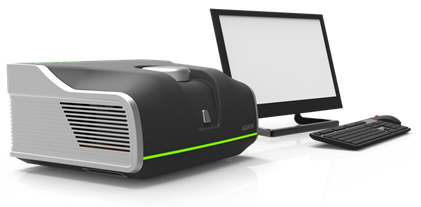Over 348 systems are installed worldwide!

The New Bench-Top Research Grade
Electron Paramagnetic (Spin) Resonance EPR (ESR) Spectrometer SPINSCAN
It is pleased to announce the capability of new generation of Bench Top X-Band Electron Paramagnetic Resonance (EPR) Spectrometer. To meet new demands SPINSCAN brings together our more than 40 year experience in EPR and state-of-the-art digital and microwave technologies.
The SPINSCAN Spectrometer is intended for EPR spectra registration in liquid or solid phases to detect paramagnetic species or free radicals. The main distinctive features of our EPR (ESR) Spectrometer are a compact electromagnet, a microwave bridge. The instrument's high sensitivity and resolution can only be bettered by systems much more expensive and much larger.
The SPINSCAN EPR (ESR) Spectrometer is provided with a fully computer controlled system including a comprehensive software package. Built-in frequency meter, magnetic field and temperature sensors, g-factor calculation and a broad dynamic range on the amplifier and the AD converter increase competitive advantages of the SPINSCAN Spectrometer and give unique solution for scientific and technological purposes.
NEW EPR (ESR) SPECTROMETER SPINSCAN HIGHLIGHTS:
• Cavity Q factor and MW power measurement
• Magnetic field modulation – 10 kHz - 250 kHz
• Phase detection range 0-3600
• First and second harmonics detection (in phase and out of phase)
• Amplitude resolution 24 bit
• Broad signal channel dynamic range - digitization up to 140 dB in one scan
• High magnetic field resolution- up to 256 000 pts for any sweep range
• Automatic self- test of system
• 2D - experiments ( magnet field vs MW power, temperature, angle)
• Interface via Ethernet
• New e-Spinoza Software– comprehensive user-oriented software kit with functions for acquisition and mathematic treatment
• New ergonomic design
HOW OUR SPINSCAN IS MADE:
Microwave Bridge: A reliable solid-state Gunn oscillator, operating at approximately 9.6 GHz, is the heart of the microwave bridge used in the SPINSCAN (ESR) Spectrometer. It provides extremely stable frequency and power output. A circulator provides good isolation and low signal loss, and the use of a reference arm allows for balanced detection, enhancing overall system sensitivity. The output frequency, phase, and bias are automatically adjusted whenever the sample is changed.
Microwave Cavity: The EPR (ESR) Spectrometer uses a rectangular TE102 cavity with a center frequency of approximately 9.6 GHz and an unloaded 0 of 5,000. Its variable iris aperture matches a wide range of sample holders and dewars, with a maximum diameter of 7.5 mm. Critical coupling of the cavity is accomplished automatically by way of the motor driven iris. Magnetic field in the cavity may be modulated up to 10 gauss peak-to-peak at 100 kHz.
Lock-in Amplifier: A Lock-in Amplifier operates at 100 kHz and performs the signal processing function for the SPINSCAN Spectrometer. The initial amplification and impedance matching between the microwave detector and the lock-in amplifier is provided by a fixed gain preamplifier in the 8400's microwave bridge. Gain, phase, and time constant are all controlled by means of the data acquisition software. Signal averaging can also be used to improve the signal to noise ratio for very weak signals.
Field Controller: The Field Controller sets and maintains the level of magnetic field applied to the sample. Field center point, scan width, and scan duration are all set from the external computer. A Hall-effect probe mounted between the pole pieces maintains the field at the required level.
Electromagnet: The electromagnet supplied with the SPINSCAN (ESR) Spectrometer features three-inch diameter pole caps which provide a field of up to 7,000 gauss. The pole caps are shimmed to provide a homogenous field over the entire sample area of the cavity. The reduced magnet gap of 1 cm results in homogeneity equal to a 4 inch or larger magnet.
TECHNICAL DATA
| Sensitivity |
8x1013 spins / T |
| Resolution |
0,006 mT |
| Maximum magnetic field |
0,7 T |
| Sweep width |
10-4 - 0,65T |
| Operating Frequency |
X-band |
| Microwave power |
0,01 - 250 mW |
| Microwave tuning |
Automatic |
| Cavity |
TE102 |
| Q-unloaded |
5000 |
| Dimensions |
530 x 420 x 350 mm |
| Weight |
56 kg; |
EPR COMMANDER SOFTWARE:
Data acquisition for EPR (ESR) Spectrometer SPINSCAN is based upon intuitive drop down menus. User selections are highlighted in the menu toolbox, and dialog boxes appear whenever a keyboard entry is required. Careful consideration was given in the design of the user interface in order to provide an environment which is easy to learn, yet powerful enough for an experienced use.
SPINSCAN SPECTROMETER SOFTWARE FEATURES:
• Spectrometer automatic control
• Base line correction
• Spectrum fragmentation
• Detection of line spectrum parameters
• Integration and differentiation
• ASCII exchange possibility
• Remote access using different network interfaces (LAN, Bluetooth)
• Operation as EPR Analyzer with special applied methods
• External accessories control (auto sampler, pump, etc.) easy to learn, yet powerful enough for an experienced user
FOR YOUR EPR (ESR) RESEARCH:
• Variable temperature control systems for wide temperature range
• Automatic sample changer
• Continuous-flow system
• Different X-band accessories (capillaries, tubes etc.)

SPINSCAN SPECTROMETER APPLICATIONS:
• Chemistry: oxidation and reduction processes, kinetics of radical reactions, spin trapping, organometallic complex, catalysis and reaction of polymerization, petrol chemistry
• Physics: magnetic susceptibility, magneto-optic properties, transition metal, conduction electrons in conductors and semiconductors, defects in crystals, recombination at low temperature, nanostructure
• Life sciences: free radicals and antioxidants, enzyme reactions, photosynthesis, metalloprotein, photochemical generation of radicals, NO in biological systems Industrial
• Research: degradation effects, polymer properties, defects in diamond and optical fibers, Impurities/defects in semiconductors
• Food dosimetry: oil & gas water quality control; brewery lag time; processing control; alanine and EPR dosimetry







